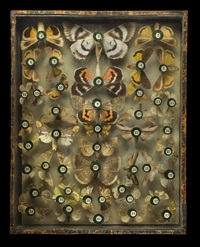History of Entomology at the Academy
Beginnings till Now

The Entomology Department began with the founding of the Academy of Natural Sciences in Philadelphia in 1812 and with Thomas Say, the great grandson of John Bartram and a charter member of the Academy. Say is considered by many to be the Father of American Entomology. At the Academy, he began his work on American Entomology, a book finally completed 25 years after his death.
Say began a tradition of journeys to wild places in search of insects and other animals. Some expeditions ended prematurely because of the dangers of the frontier, like the hazards of traveling across the Rocky Mountains. Say married Lucy Sistaire, an artist and specimen illustrator, who became the first female member of the Academy. Lucy Sistaire donated Say's library and entomology specimen collections to the Academy after his death.
Expeditions to remote places continued throughout the 19th and 20th century and continues today. Between 1905 and the 1940s, Morgan Hebard and James Rehn surveyed the entire western United States, adding more than 500,000 orthopteroid insects (grasshoppers, crickets, katydids and their relatives) to the Academy's collection.
|

|
The Titian Peale Butterfly and Moth collection, the oldest collection of insects in the United States, provides an invaluable resource of study for assessing the changes in the Pennsylvania's environment in the past 150 years. In 1860 Ezra T. Cresson, one of America's most important early entomologist, gave his entire collection of more that 60,000 beetles and wasps to the Academy. In 1867, Brackenridge Clemens gave a large collection of Microlepidoptera (moths) and in 1897 George Horn gave his collection of over 50,000 beetles. The largest collection given to the Academy came from Morgan Hebard, who donated his collection of over 500,000 orthopteroid insects (grasshoppers, crickets and related insects). The most recent donation is the gift of the Robert T. Allen collection, encompassing approximately 20,000 specimens of North American insects, particularly Apterygota (primitively flightless soil insects).
|
The American Entomological Society

The Academy’s Entomology Department and the American Entomological Society have mutually benefited from a nearly 150 year relationship that continues to the present. The American Entomological Society founded in 1859, moved its rooms, library and collections to the Academy in 1876. This formed the nucleus of the rapidly expanding entomology collection.
The first president of the Society was John L. LeConte (1825-1883) and one of its founders, Ezra Cresson (1838-1926), deposited his important Hymenoptera types here. The Society's office is located adjacent to the departmental offices, its entomological collection is integrated in the department's collection and its meetings were held at the Academy until recently when its meetings became virtual. The Society's world renowned entomological library is housed in the Academy's Library and Archives and the Society budgets funds each year to purchase entomological books and journals for the library.
Photography © Robert Clark